Looking back: Memorial Hall hosted performers, politicians and parties

A crowd of more than 3,000 gathered on Oct. 21, 1964, at Memorial Hall to hear President Lyndon Johnson, the first sitting president to visit UA, speak in the waning days of that year's presidential campaign. — University Archives
FOR MEMORIAL HALL, it started with the hoops and it ended that way, too.
From the men’s basketball game that followed its dedication on Dec. 11, 1954, to June 26, 2010, when the Zips hosted the building’s final event — a shoot-out tournament for area high school boys’ basketball teams — Memorial Hall has reverberated with the sounds of athletic competition.
And so much more.
The sandstone-colored building will be coming down, starting July 19, to make way for a new College of Education. For generations of alumni, Akron area residents and members of the UA community, the change in landscape is bittersweet — the building holds so much history.
For its first three decades, Memorial Hall was the University’s original “town and gown” building. Not just home to UA’s basketball teams, the gymnasium was large enough to accommodate events ranging from homecoming dances and commencements to military and charity balls, blood drives, rock concerts and political rallies. Community swim classes and meets were hosted at its pool.
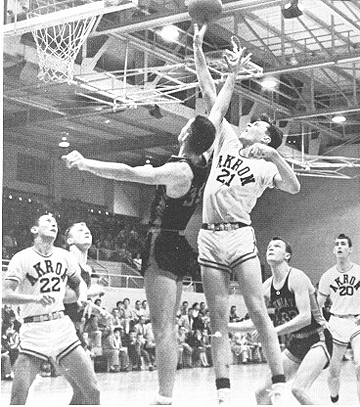
The Zips won 17 of 22 games during the team's first season on the new home court. — 1955 Tel Buch
Sitting president greets crowds
President Lyndon Johnson was among the national figures to deliver speeches at Memorial Hall. He and his opponent during the 1964 campaign, Arizona Sen. Barry Goldwater, made stops five days apart. During the 1968 presidential race, eventual winner Richard Nixon and wife Pat appeared at a rally in the gym.
The issues facing America at any particular time are reflected in the names of other speakers at the podium in Memorial Hall — from consumer advocate Ralph Nader to comedian and civil rights activist Dick Gregory. Even Pat Paulsen, another comedian and perennial presidential candidate, shared his wry take on life with a wildly enthusiastic Memorial Hall audience.
Though acoustics were less than ideal, the gym was the venue in Akron for bands like Chicago, the Fifth Dimension and Sergio Mendes & Brasil ’66, along with Ray Charles and Stevie Wonder.
Over time though, uses for Memorial Hall shifted as the campus grew to include E.J. Thomas Performing Arts Hall, James A. Rhodes Arena, Ocasek Natatorium and the Student Recreation and Wellness Center. In recent years, Memorial Hall was home to physical education and general studies classes, intramural sports, tournaments and provided practice space for UA’s cheer and dance teams.
Now, InfoCision Stadium-Summa Field and the other athletic-use buildings fill these needs.
Premium space to be repurposed
“Memorial Hall has served this campus very well,” notes Ted Curtis, UA’s vice president of capital planning and facilities management. “However, it is beyond it's time to function appropriately and with the addition of other new spaces, this building is no longer required.”
The focus these days, says Curtis, is building additional academic space to accommodate UA’s growing enrollment.
“The need for a new College of Education building is upon us, and the location at Memorial Hall will be very appropriate and work well with the Master Guide Plan,” adds Curtis, who has overseen UA’s most recent period of expansion, the New Landscape for Learning, since its inception in 2000. “The new facilities will be designed to serve this campus for the next 50 years and we look forward to bringing together the appropriate design solutions to properly train our future teachers.”
Present echoes past
It was a similar need to meet growing enrollment that led to the construction of Memorial Hall — the first of 13 structures built during the 20-year term of UA’s 10th president, Norman P. Auburn. Much of the expansion was accomplished when UA was still the Municipal University of Akron, and relied on local tax levies for operating and capital funding.
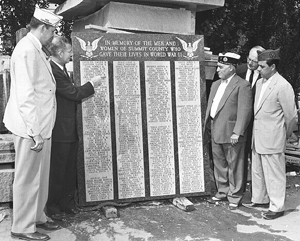
President Norman P. Auburn, second from left, and retired military members view one of the granite memorials to Summit County's World War II dead. — University Archives
Ground was broken for the campus’ first modern physical education building on April 8, 1953.
The 33,000-square-foot structure, built at a cost of $1.4 million, was ready for classes in fall 1954. It replaced Crouse Gymnasium, which, built in 1888, was the oldest structure on campus at the time.
Memorial Hall was dedicated with solemn fanfare on Dec. 11 — chosen to serve as Summit County’s memorial to the 1,534 residents who had died serving their country during World War II.
The red granite plaques bearing their names that lined the main entrance to Memorial Hall will be the part of the building that remains.
These plaques, along with two others that honor lives lost in World War I and Vietnam, will become part of an armed services memorial near Bierce Library where UA’s Korean War Memorial has been in place since 2001.
More photos below. All photos are courtesy of University Archives.

President Norman Auburn, third from left, reviews plans for Memorial Hall, named to honor those from Summit County who died in service to their country during World War II.

The newly finished Memorial Hall was the first UA building to extend beyond the northeast corner of the old Buchtel College campus.

The Memorial Hall gym boasted seating for 3,000.

The Memorial Hall pool on ground level was open to campus and the community.
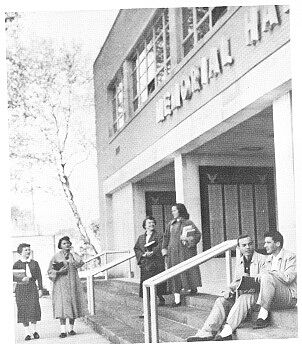
Students gather on the steps of Memorial Hall in this photo from the 1955 Tel Buch.

Visitors leave Memorial Hall after an event.
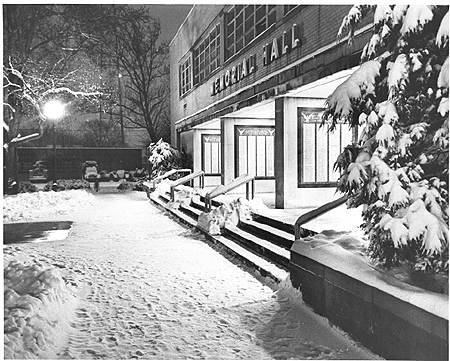
A winter scene with Memorial Hall.

Military balls were among the many “town and gown” events hosted in the Memorial Hall gym. This photo appeared in the 1962 Tel Buch.

President Norman P. Auburn delivers a convocation address in Memorial Hall in this 1962 Tel Buch photo.

President Lyndon Johnson addresses a rally in Memorial Hall on Oct. 21, 1964. Among those visible behind him on the stage are his wife, Lady Bird, and, to her right, President Norman P. Auburn.

Three hundred graduates stream into Memorial Hall for commencement in 1968. — 1968 Tel Buch
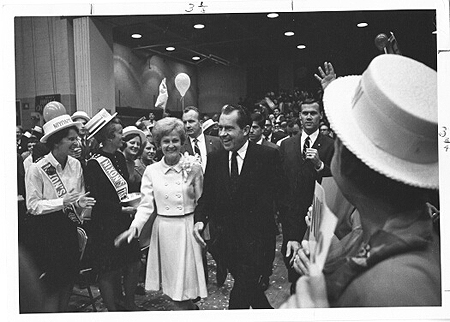
Presidential candidate Richard Nixon and his wife, Pat, attend a rally at Memorial Hall during the 1968 campaign.

Presidential candidate Richard Nixon addresses a crowd in Memorial Hall.

These photos from the 1971 Tel Buch show the band Chicago performing in Memorial Hall.
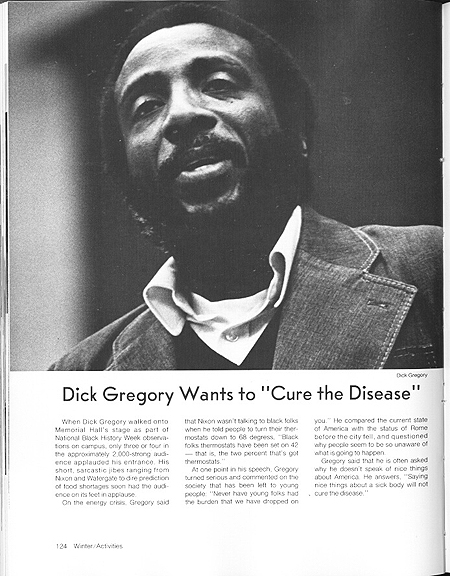
Comedian and civil rights activist Dick Gregory spoke at Memorial Hall to an audience of more than 2,000 during Black History Week. — 1974 Tel Buch
Wanted: Your
Memorial Hall memories
From classes to concerts to athletic events and so much more, many of us have special memories of time spent in Memorial Hall. If you’d like to add yours to those we’ve posted here, please e-mail them to stories@uakron.edu for this online memory book.
"I remember seeing Chicago play at Memorial Hall,” writes Canal Fulton resident Rick White, who was a freshman when the band performed here in 1970. “I was up near the rafters, with the horn section pointed right at me. I couldn’t hear well for a few days after!"
But it is the Memorial Hall pool that White, also a member of UA’s cross-country track team, says he remembers most vividly.
"One of our hardest workouts was running laps across the pool at Memorial Hall for Coach Campbell (Al Campbell, head cross country/track and field coach from 1968-95). Our track was not in the best of condition, but after running the pool, I loved it.
"Memorial Hall was a place where dreams of being a great college athlete began. Not many succeeded, but many had the dream, and for most of us, that’s a memory no one can take away."
"Basketball was really big — I went to many games because the Zips were so good." — Dianne (Bachmann) Capitena, B.S.E. 1976, M.S.E. 1983
"I remember the place was packed for basketball games. I also remember when we went to Evansville, Ind., (in 1972) to compete for the national title.
"When registration for classes was held in Memorial Hall, there were long lines and it took hours to register. You’d stand in one line and have to go stand in another." — Cheryl (Mack) Urban, AASSS 1968, B.A. 1990, M.P.A. 1996
"Yes, basketball was the 'Main Event,' sorry Lyndon and Richard (it was great having you there!) ... but the best was when Earl, 'The Pearl' Monroe came to town and exhibited his amazing basketball talent! ... sorry to see you go old hall, but then we also had to say good-bye to 'The House that Ruth Built!'" — Peter Walsh '68
"I don't know where to begin. I worked there for Herm Farley running the student 'Court Patrol' for a few years (76-79). I ventured through every part of the building; from the steam bath of the football teams first weight room underneath the pool, to the tunnels that go to Buchtel Hall and other buildings. I prepared the court for all of the basketball games and worried if the baskets would come down straight (or at all). I always looked forward to the floor being resurfaced each year. Many times I set up the tables and chairs for AA meetings and other large gatherings. From the rooms behind the bleachers, the coaches’ offices downstairs, basketball pick up games between classes, indoor baseball practices, women's basketball and volleyball games, Memorial Hall had personality like no other when I was there. I will miss not seeing it when I visit each year." — Kevin Meyer
"I remember the days of playing intramurals in the late 90s in the gym and also the number of college party venues hosted by students … those were some good parties and really made the spirit of the University a place I like to call home. My fraternity threw a Homecoming Celebration in 1998, where I won Homecoming King in Memorial Hall." — Tierney Bates, B.A. 1999, M.A.E. 2002
"Memorial Hall was a place on campus where you could just relax and enjoy the simple life of college days. It was my 'escape spot' on campus. The building had so much hidden history that many did not know. Every visit to the building, you would learn something new. The funniest moment was the campus scavenger hunt, 'Find the pool in Memorial Hall.' I had always wondered, 'Why does this building smell like chlorine?' Ha ha." — Deanna Gaskins,
Incoming Class '98
"I remember proudly the concerts we students held at Memorial Hall during my years at The University of Akron. They included: The Eagles, The J. Geils Band, Hawkwind, The Dave Mason Band, Leonard Skynard Band and Stevie Wonder.
"I got to see Dionne Warwick for free by climbing into an open men's restroom window on the southwest side of Memorial Hall. And my Bulger Hall floormates (14th floor) became my guests when I opened a nearby door for them. I guess I owe UA the cost of three concert tickets!
"It is my wish that InfoCision Stadium-Summa Field can live up to Memorial Hall's excellent concert legacy. Back then, we made Kent State University jealous over our concerts and major events presentations.
"Great memories, yet all good things come to an end and are replaced by even better!" — David Culp, B.A. 1975, AAS, 1976, former major events chairman, Student Center Program Board (1973-1975).
"I am still fairly new to the University of Akron, and was only able to experience Memorial Hall for a year. Every morning of my freshman year, I would arrive early, grab a chai from the Starbucks in the union, and hang out with one of my best friends on the front steps of Memorial. These mornings helped me get through some of the most difficult times of my life to date, and I will never forget them, or how calming the Memorial Hall front steps were in those brisk fall and spring mornings." — Ian Brockway

